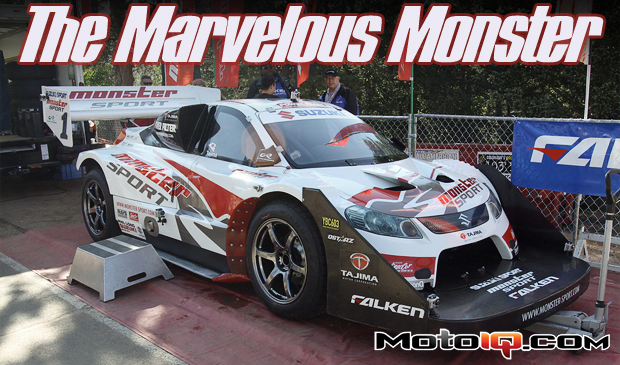,
 |
| The rear A arm suspension looks like it doesn’t have much negative camber gain under roll. We are curious why. The suspension has a lot of travel, much more than the PM580. Note the large amount of droop which is important on rough surfaces. Also note the extreme angle of the coil over Reiger shock. We are curious as this will tend to give a regressive falling wheel rate, the opposite of what we think would be wanted. The rear sway bar is very conventional. The suspension looks to be very robust and sturdy. |
 |
| We can see that the shock is probably high mounted to protect it from flung gravel and to get it out of the airstream in the super huge venturi tunnel. What we are curious about is why the whole rear tire is hanging into the tunnel. This is a real bad disruption of air flow and seriously reduces the tunnels effectiveness. We wonder why this is done that way. Monster Sport has an in-house windtunnel, perhaps they know something we don’t which is against conventional wisdom? |
 |
| The front suspension is very similar to the rear but with a better camber curve and a lower roll center location. Note the extreme shock angle, much like the rear. The steering rack should be slightly higher for less bumpsteer but the steering has good Ackerman which is good for dirt driving technique. Ideally the steering rack could even be inline with the UCA plain like in the PM580. Like the rear the front swaybar is a conventional straightforward type. |
The suspension is also very straightforward, unequal length tubular A-arms, with top mounted remote reservoir double adjustable Reiger shocks. Reiger shocks are commonly used in Europe on Rally cars including WRC cars. We can understand the top mounting in the rear to get the dampers out of the tunnel to clean up its airflow but we wonder why this was done in the front. The top mounting means that the shocks have to be canted in at a sharp angle to keep a reasonable deck and fender height which probably means a regressive wheel rate. It probably would have been better to use a push rod and rocker arrangement to get a progressive rate. The front steering rack is also mounted a little low and may get some bump steer although its forward location is good which should help turn in. The car uses conventional antiswaybars which are adjustable.
 |
| The front brakes feature huge 370mm full floating lug drive rotors and 4 pot Brembo forged monoblock racing calipers. The rear mounted caliper offers better self aligning torque and is less prone to piston knockback from flex in the upright or bearing system.. |
 |
| The rear brakes are like the fronts but have a slightly smaller 350mm rotor. AWD cars have superior braking since having all wheels coupled makes individual wheel lock up less likely. |
The brakes on a supercar are very important and the Monster is no exception. Front and rear Brembo motorsport monoblock 4 piston calipers grab huge 370mm front and 350mm rear floating rotors. Winmax brake pads are used. Hydraulics are handled by Tilton master cylinders and balance bar as far as we can tell.
 |
| We are convinced that these are very special Falken Wildpeaks indeed. The car goes though a set of these tires in one run to the top. The forged Rays wheels are light and strong. |
 The
The
You can see the front leading edge of the barge boards running down the side of the car. These help improve the effectiveness of the undercar tunnels by reducing the amount of air curling under the car.
The tires on the beast are huge Falken Wildpeak off roads in 285/50-20 on 20×11 forged Rays VR G2 wheels. We have a feeling that these Falkens are very special as the rubber felt very soft!
 |
| The huge multi element rear wing dwarfs the large car. A lot of aero is needed as Pikes Peak is mostly done at lower speeds. In thin air the aero does not work at all like at sea level. Note the side gurneys on the wing end plates. These increase the effectiveness of the main element. |
The uh, Suzuki’s bodywork is built from dry carbon and Kevlar. There are many scoops and ducts for many heat exchangers. We counted one huge engine coolant, two intercooler and various sundry others for the transmission, center diff and rear diff all with various ductwork. The rear wing is a huge bespoke multi element unit needed to create downforce at low speeds in thin air. The front has the hugest splitter I have ever seen on a racer and there are two huge full length diffusers under the car. Many of the car’s aero revisions from last year have been to optimize the car more for tarmac as this years course has more tarmac and less dirt. This meant less drag and aero designed to function better at higher speeds. Supposedly the car spent a lot of time in the wind tunnel to do this.
 |
| The biggest splitter known in the automotive racing world lives here. The huge side plates increases the splitter’s effectiveness by creating high pressure stagnation in the zone around the fenders, increasing the pressure differential between the top and bottom of the splitter. The major difference between the 2009 and 2010 aero is that the 2010 version lacks the large diveplanes on the outside of the side plates that were very prominent on the 2009 car. Diveplanes are not efficient downforce generators and usually incur a large drag penalty. |
 |
| We are not sure why the leading edge of the splitter is so tall and boxy, perhaps it is to reduce pitch sensitivity but we think other methods might be more effective with less drag. However Monster Sport has a wind tunnel and we don’t! |
 |
| The huge rear wing as viewed from the front. This wing is highly effective at low speeds in thin air. The rearward cantilevered mounting also increases its effectiveness by acting like a lever arm on the rear tires. |
 |
| Fender louvers help prevent air from building up inside the wheelwell. This increases the effectiveness of both the splitter and the rear tunnels. |


